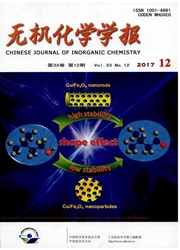

 中文摘要:
中文摘要:
衔接的三个金属离子自我装配(SA ) cis-di (thiocyanato ) 拍摄 -bis(2,2-bipyridyl-4,4-dicarboxylate) 钌被接触角度,紫外系列,周期的 voltammetry 和 XPS 制作并且描绘。他们的 photoinduced 电子转移性质(PETP ) 被检验。在题为的系统之中, 17731843 nA/cm2 的最高稳定的阳极的光电流和 3.2% 的最高的量收益被完成。事件光紧张,偏爱电压,和电子施主的效果也被学习。电子转移的可能的机制被建议。结果表明在 SA 电影的那个不同金属离子能显著地影响 photoinduced 电子转移性质。我们的试验性的结果清楚地证明衔接金属离子能在这些自我装配的系统起功能、结构的作用。形成功能的电影的这个方法能提供一条新途径调整类似的系统的性质。
 英文摘要:
英文摘要:
Three metal ion bridged self-assembled (SA) films of cis-di(thiocyanato)-bis(2,2'-bipyridyl-4,4'-dicarboxylate) ruthenium were fabricated and characterized by contact angle, UV spectra, cyclic voltammetry and XPS. Their photoinduced electron transfer properties (PETP) were examined. Among the titled systems, the highest steady anodic photocurrent of 1773-1843 nA/cm^2 and the highest quantum yield of 3.2% were achieved. The effects of incident light intensity, bias voltage, and electron donor were also studied. The possible mechanism of electron transfer was proposed. The results reveal that different metal ion in SA films could affect significantly the photoinduced electron transfer property. Our experimental results clearly show that bridging metal ions can play both functional and structural roles in these self-assembled systems. This method of forming functional films can provide a new approach to regulate the property of similar systems.
 同期刊论文项目
同期刊论文项目
 同项目期刊论文
同项目期刊论文
 期刊信息
期刊信息
